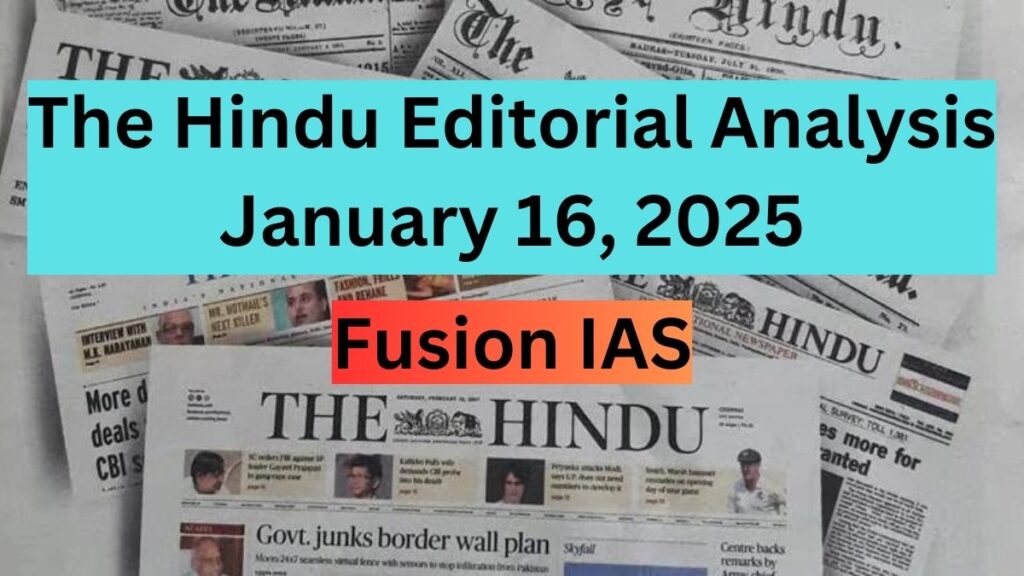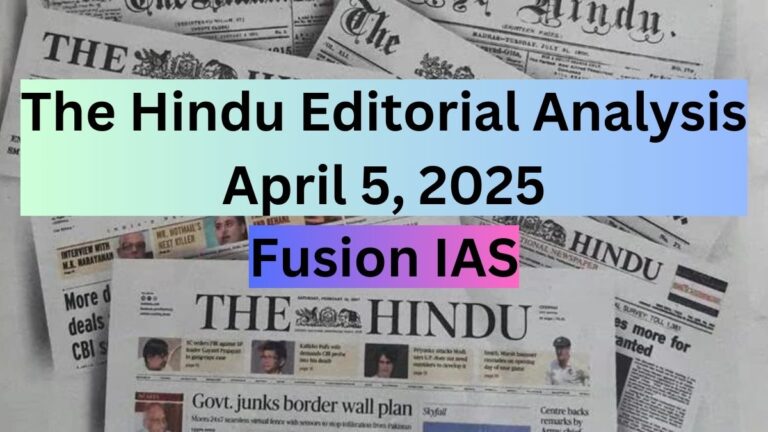
The Hindu editorials are a crucial resource for understanding key national and international issues. This analysis simplifies complex topics, highlights key points, and offers critical insights, making it an essential tool for competitive exam preparation like UPSC CSE and developing a well-rounded perspective on current affairs.
1. OYO’s new policy may be at the cost of rights
- Policy Announcement:
- OYO has implemented a policy disallowing unmarried couples from accessing its partner hotels.
- Couples must provide “valid proof of relationship” to check in.
- Initially applicable in Meerut, Uttar Pradesh, with potential expansion to other cities.
- OYO claims the policy stems from requests by civil society groups.
- Impact of the Policy:
- Encourages partner hotels to discriminate against customers based on marital status.
- Likely to exacerbate privacy issues faced by individuals in pre-marital relationships.
- Affects not only unmarried couples but also friends, colleagues, or relatives traveling together.
- Constitutional Perspective:
- Article 21: Supreme Court rulings affirm individuals’ rights to privacy, dignity, and autonomy, including:
- The right to choose partners (Shafin Jahan vs Asokan K.M., 2020).
- The right to companionship (Navtej Singh Johar vs Union of India, 2018).
- Denying hotel services may impede the exercise of these rights.
- Article 21: Supreme Court rulings affirm individuals’ rights to privacy, dignity, and autonomy, including:
- Vertical vs Horizontal Application of Rights:
- Fundamental rights under Part III of the Constitution are enforceable primarily against the State (“vertical” application).
- Rights against private entities (“horizontal” application) are limited but evolving.
- Relevant Constitutional Provisions:
- Article 15(2): Prohibits discrimination in access to public services based on religion, race, caste, sex, etc., but does not explicitly include marital status.
- Article 17: Abolishes untouchability.
- Article 23: Prohibits human trafficking and forced labor.
- Kaushal Kishor vs State of Uttar Pradesh (2023): Recognized the enforcement of Article 21 against private parties, though its applicability remains unclear.
- Legislative Gaps:
- Need for anti-discrimination laws to protect individuals from biases based on marital status, gender, sexual orientation, or other attributes in the private sphere.
- Existing statutes confer rights to women irrespective of marital status, but broader protections are lacking.
- Social and Legal Implications:
- Private entities, like OYO, play a role in enabling or hindering the exercise of constitutional rights.
- Discrimination in private spheres (e.g., renting homes, employment, land purchases) highlights the “tyranny of the majority.”
- Legal protections must ensure the freedom to act within constitutional guarantees, regardless of societal approval.
- Conclusion:
- The policy raises critical questions about balancing societal norms with constitutional rights.
- Advocates stress the importance of creating legal frameworks to safeguard individual autonomy and equality in private transactions.
2. Safety and piety: On safety and religious pilgrimage sites
- Incidents and Statistics:
- On January 8, 2025, a stampede at the Tirumala temple in Tirupati resulted in six deaths and over 40 injuries.
- India has the highest number of religious stampedes globally, with over 3,000 lives lost between 1996 and 2022 (NCRB data).
- Causes of the Stampede:
- Despite extensive crowd control measures, such as token distribution, deployment of 3,000 personnel, and volunteers, a miscommunication triggered chaos.
- Stampede-like situations are often a result of sudden surges and mismanagement.
- Existing Measures at Tirupati:
- Online booking systems and additional security during peak periods.
- Token distribution strategy to streamline crowds.
- Recommendations for Safety:
- Pilgrim Prioritization: Prioritize first-time visitors over repeat pilgrims to ensure equitable darshan.
- Regulating VIP Darshan: Rethink VIP privileges to enhance fairness.
- Database and Roster System: Develop a robust system to regulate the flow of devotees.
- Ecological Concerns:
- Tirumala Hills, part of the Seshachalam Biosphere Reserve, face threats from deforestation, urbanization, and massive footfalls.
- Growing anthropogenic pressures threaten the region’s biodiversity.
- Suggestions for Ecological Preservation:
- Cap the number of pilgrims per day.
- Promote virtual darshan experiences to reduce footfall.
- Implement stricter conservation policies to safeguard biodiversity.
- Collaborative Approach:
- Religious authorities, government agencies, environmental experts, and the public must work together to ensure safety, accessibility, and ecological sustainability.
- Broader Implications:
- Balancing safety and environmental preservation with spiritual needs requires innovative and sustainable solutions.
3. The red flag as China’s expansionist strategy rolls on
- Recent Chinese Aggression:
- Dam Construction: China’s announcement of building a hydropower dam on the Yarlung Zangbo (Brahmaputra) near the India-China border raises strategic concerns for downstream countries like India and Bangladesh.
- Territorial Claims: Creation of two new counties in north-eastern Ladakh reflects China’s continued cartographic aggression.
- Impact on India:
- Threatens territorial integrity and sovereignty, undermining the recent troop disengagement consensus along the LAC.
- Water security risks for downstream countries due to reduced water and silt flow from the proposed dam, impacting agriculture, biodiversity, and fisheries.
- Risk of floods during monsoon or geopolitical tensions from China’s control over water release.
- India’s Response:
- Strong condemnation of China’s actions as illegal.
- Expedited hydropower projects in Arunachal Pradesh, with $1 billion invested in 12 new projects.
- China’s Cartographic Aggression:
- Asserts territorial claims through renaming locations, establishing settlements, and altering maps.
- Recent actions include standardizing locations in Arunachal Pradesh (2023, 2021, 2017) as part of its claims.
- Lacks legal validity under international law, as demonstrated by rulings like the ICJ’s Minquiers and Ecrehos case, which prioritizes effective administrative control over cartographic claims.
- Broader Implications in South Asia:
- Other South Asian countries like Nepal and Bhutan also face territorial disputes and transboundary water issues with China.
- Bilateral engagement with China has been the norm, leading to fragmented regional responses.
- Comparison with Southeast Asia:
- ASEAN and Mekong River Commission (MRC) offer examples of collective responses to Chinese assertiveness.
- South Asia lacks such multilateral frameworks, leaving individual nations vulnerable.
- Recommendations for India and South Asia:
- Unified Regional Response: India, as the dominant regional power, should lead efforts to establish collective mechanisms.
- Multilateral Coordination: Enhanced cooperation through regional forums to counterbalance China’s influence.
- Diplomatic Engagement: Proactive strategies to address both territorial and water-related challenges.
- Sustainability Measures: Strengthen infrastructure and policies to mitigate risks from China’s projects.
- Strategic Outlook:
- A comprehensive strategy encompassing regional diplomacy, multilateral engagement, and infrastructural development is critical to safeguard India’s sovereignty and regional stability against China’s expansionist tactics.
4. Burrow tragedy: On the coal mining tragedy in Assam’s Dima Hasao
Also Read: The Hindu Editorial Analysis: January 14, 2025
Disclaimer:
This analysis is based on the editorial content published in The Hindu and is intended solely for informational and educational purposes. The views, opinions, and interpretations expressed herein are those of the author of original article. Readers are encouraged to refer to the original article for complete context and to exercise their own judgment while interpreting the analysis. The analysis does not constitute professional advice or endorsement of any political, economic, or social perspective.
Follow Fusion IAS


